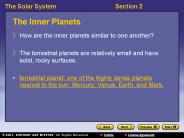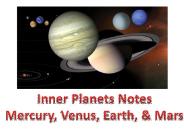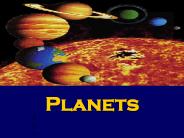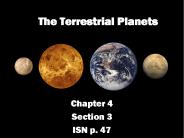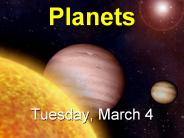Inner Planets PowerPoint PPT Presentations
All Time
Recommended
Inner planets - middle school
| PowerPoint PPT presentation | free to download
The Inner Planets
| PowerPoint PPT presentation | free to download
Inner Planets The 4 inner planets are small and have rocky surfaces They are known as the terrestrial planets The are more similar to each other than ... life evolved ...
| PowerPoint PPT presentation | free to view
Title: No Slide Title Author: Burkett, Kevin Last modified by: Burkett, Kevin Document presentation format: On-screen Show (4:3) Other titles: Arial Times Arial ...
| PowerPoint PPT presentation | free to download
Introduction to Inner Planets Terrestrial planets means that the planet is made up of rock Organized atmosphere that makes them different from the outer and dwarf ...
| PowerPoint PPT presentation | free to download
Venus's atmosphere is filled ... It is the only planet known that has liquid water and ... volcano in the solar system, called Olympus Mons (inactive) ...
| PowerPoint PPT presentation | free to view
Inner or Terrestrial Planets All the inner planets formed at the same time. Their composition is also very similar. They lack the huge atmospheres of Jovian planets.
| PowerPoint PPT presentation | free to view
The Inner Planets
| PowerPoint PPT presentation | free to view
The Inner Planets: Geology Inner planets vs outer planets Making surfaces Sources of heat Interiors, layering and why Surface Area to Volume ratio and how it controls ...
| PowerPoint PPT presentation | free to view
Many moons most famous are the Galileon moons (4) Saturn Thick atmosphere of H and He The density of Saturn is less than water!
| PowerPoint PPT presentation | free to view
Fact: All major (currently observed) planets/moons/asteroids are revolving ... The number of collisions between objects depends on how many objects there are ...
| PowerPoint PPT presentation | free to download
Closest to the sun. No moons. Hard to view b/c so close to sun ... Other moons Tethys, Lapetus, Dione, and Rhea. Uranus. Much smaller than Jupiter and Saturn ...
| PowerPoint PPT presentation | free to view
... are: Jupiter, Saturn, Neptune, Uranus, and Pluto! The Outer Planets! ... Saturn is the 2nd largest planet. And Pluto is the smallest and no longer a planet. ...
| PowerPoint PPT presentation | free to view
... Jovian year 1 Jovian day = 12 EH Huge storms Great red spot hurricane larger than Earth Some moons may have water Saturn 29 years to orbit Large rings ...
| PowerPoint PPT presentation | free to view
Learn to enhance the inner beauty with the help of ayurveda.Unlock the inner peace hidden inside by aligning your body mind and soul in accordance to each other.
| PowerPoint PPT presentation | free to download
The Planets of Our Solar System Name the planets as they go around the sun. Facts Each one rotates and revolves Rotation the time it takes to spin on its axis ...
| PowerPoint PPT presentation | free to view
Pluto. Mercury. Venus. Mars. 4. Which Planet has extreme temperatures because of its atmosphere? ... Pluto. 7. Which planet rotates on its side? Jupiter ...
| PowerPoint PPT presentation | free to view
The Inner Solar System Earth-like ... The Outer Solar System- The Jovian Planets. Is Pluto a planet, or it is an asteroid ? The 10th Planet of the Solar System ...
| PowerPoint PPT presentation | free to view
Testing Simple Parameterizations for the Basic Characteristics of the Martian Ionosphere (How does the martian ionosphere respond to changes in solar flux?)
| PowerPoint PPT presentation | free to download
Venn Diagram for Inner and Outer Planets Inner Outer Called terrestrial Small and rocky surfaces Have solid surfaces Close to the sun No other planet has oceans like ...
| PowerPoint PPT presentation | free to download
Heating of interior due to tidal stresses from Jupiter and other moons. Page 33 ... Jupiter's moon Europa: ice surface floating on underground ocean? Is there ...
| PowerPoint PPT presentation | free to view
The second planet from the sun is Venus. Venus is about as big as Earth. ... Mars has been nicknamed 'the red planet, because it has red soil. ...
| PowerPoint PPT presentation | free to view
the masses of major chemical reservoirs ... k Love numbers for solid/liquid core and different core sizes. liquid. solid. ROB. Rotation ...
| PowerPoint PPT presentation | free to view
Only 2 documented cases in which a person is hit by a meteorite. Two documented Cases ... Capture of Comet Shoemaker by Jupiter. The Age of the Solar System ...
| PowerPoint PPT presentation | free to view
Come up with a new mnemonic for the first eight planets. ( Prepare ahead of time) ... This will make your learning experience a better one. Page 51. Guidelines ...
| PowerPoint PPT presentation | free to view
Planets & Distance Essential Questions: What are the major components of the universe? (SPI 0601.6.1) How does the distance of objects in space from Earth affect how ...
| PowerPoint PPT presentation | free to view
Planets & Distance Essential Questions: What are the major components of the universe? (SPI 0601.6.1) How does the distance of objects in space from Earth affect how ...
| PowerPoint PPT presentation | free to view
Planets Planets Definition Of A Planet An object in orbit around a star but does not give off its own light, Rather it shines by reflecting sunlight.
| PowerPoint PPT presentation | free to download
Planets & Distance Essential Questions: What are the major components of the universe? (SPI 0601.6.1) How does the distance of objects in space from Earth affect how ...
| PowerPoint PPT presentation | free to view
The Terrestrial Planets Chapter 4 Section 3 ISN p. 47 The Terrestrial Planets The terrestrial planets are the inner four planets of Mercury, Venus, Earth, and Mars ...
| PowerPoint PPT presentation | free to download
Definition Of A Planet. An object in orbit around a star but does not give ... Pluto - Pluto is a rocky planet that is usually the farthest planet from the Sun. ...
| PowerPoint PPT presentation | free to view
The Outer planets By: Ian McGorray Kevin Bhasin Gnana Umpathy Dean Bizga The Outer Planets overview General Facts There is a very great distance between the inner and ...
| PowerPoint PPT presentation | free to download
For decades, Pluto was called the 'ninth planet'...though a very unusual planet. ... Are Pluto and Eris planets? International Astronomical Union definition of ' ...
| PowerPoint PPT presentation | free to download
This gas giant is the largest planet. Saturn - Saturn is the sixth planet from the Sun. This gas giant has large, beautiful rings. Uranus ...
| PowerPoint PPT presentation | free to download
OUTER PLANETS-PLUTO. Takes 438 years to make a single revolution around the sun ... Pluto is no longer considered a planet, instead, it is the largest of the ...
| PowerPoint PPT presentation | free to view
Middle School level
| PowerPoint PPT presentation | free to download
... is the only planet that has life on it. On Earth you can find ... might have been liquid water and life on Mars, but nothing has been found to prove that yet. ...
| PowerPoint PPT presentation | free to view
The Planets Discussing Planets Measure distances to planets in Astronomical Units (AU). 1 AU = distance from Earth to the Sun = 93 million miles.
| PowerPoint PPT presentation | free to view
Planetary Motion Each planet spins on its axis. The spinning of a body, such as a planet, on its axis is called rotation. The orbit is the path that a body follows as ...
| PowerPoint PPT presentation | free to download
... Mass (kg) unknown, small dark, unknown Neptune Large paricles Carbonaceous Uranus
| PowerPoint PPT presentation | free to download
They are also known as the rocky or inner planets ' ... Structure of the earth, inner core, outer core, mantle(asthenosphere, lithoshere), crust. ...
| PowerPoint PPT presentation | free to view
... the stronger gravity of larger bodies: The planet itself and some of the larger ... is known: the tidal stability limit at 2.5 times the radius of the body. ...
| PowerPoint PPT presentation | free to view
Solutions for assignment 2 are up the in solutions cabinet on the 3rd ... Kardyshev classification & Dyson spheres. SETI II (Book: 281) 12. SETI I (Book: 281) ...
| PowerPoint PPT presentation | free to view
Early Missions to the Inner Planets. 1962 -- Mariner 2 Venus Fly-by. 1964 ... Water washes CO2 out of atmosphere where it is eventually deposited as rock ...
| PowerPoint PPT presentation | free to view
Navigate challenges with Divya Astro Ashram's expertise in Ashubh Grah analysis. Our astrologers identify malefic planetary influences that may impact various aspects of your life. Receive personalized remedies and guidance to pacify Ashubh Grah, ensuring a smoother and more positive life journey.
| PowerPoint PPT presentation | free to download
Terms: The Planets Mercury Venus Earth Mars Pluto (Dwarf Planet Jupiter Saturn Uranus Neptune
| PowerPoint PPT presentation | free to download
Extrasolar planets
| PowerPoint PPT presentation | free to view
The Earthlike Planets. Planets of the Inner Solar System. Earth. Molten ... Lobate scarps. History of Mercury. Differentiation. Major collision. Heavy cratering ...
| PowerPoint PPT presentation | free to view
Saturn size. Neptune size. collisionless lifetime. Dynamics at low ... Mp Saturn. Larger masses also would leave structure in ring, and it is featureless ...
| PowerPoint PPT presentation | free to download
Planets lists... List the planets in our solar system in order, starting with ... Mercury (closest to the sun) Venus, Earth, Mars, Jupiter, Saturn, Uranus, Neptune ...
| PowerPoint PPT presentation | free to download
Searching for Alien Worlds
| PowerPoint PPT presentation | free to download
Introduction Inner Terrestrial Planets
| PowerPoint PPT presentation | free to download
Delve into the world of Vedic Astrology planets with MyPandit. Learn about the Sun, Moon, Mars, Mercury, and more—discover their unique meanings and cosmic influences on your life journey.
| PowerPoint PPT presentation | free to download
Uranus. Neptune. Pluto. Inner Planets. Outer Planets ... Mars, Jupiter, Saturn, Uranus, Neptune, and Pluto. Mercury ... Jupiter, Saturn, Uranus, and Neptune. ...
| PowerPoint PPT presentation | free to view
(1) Ceres, (2) Pallas, (3) Juno, (4) Vesta. Minor planet numbers: ... Damocles (q=1.58 AU; Q=22 AU; i=62 ) 30 in Jupiter Family orbits ...
| PowerPoint PPT presentation | free to view




